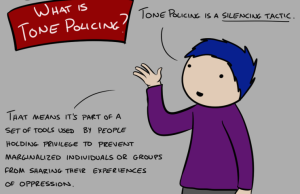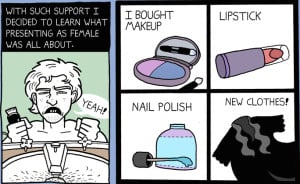When I was a kid, I hated wearing dresses and insisted on overalls. I also hated pink and didn’t want anything to do with that color. All of these things distressed my mom, who would buy me skirts and pink shirts only to have them rejected.
I hated her insistence on making me wear those clothes, but now that I’m older, I understand where she was coming from. Like many people, she believed that because I was a girl, I should wear skirts and dresses.
She was also probably familiar with the way people who break gender norms are ridiculed and even attacked. Why would she want her child to step outside the boundary of what society deems acceptable if it will only garner negative consequences?
And what our society deems acceptable is that there are certain clothes that girls should wear, and certain clothes that boys should wear. Anyone who trespasses those boundaries is looked upon with suspicion.
That’s because our society enforces gender essentialism, or the belief that there are inherent differences between women and men.
Because of these differences, women and men are supposed to feel, act, and even dress differently. It’s like that old and annoying saying: “Women are from Venus, men are from Mars.”
First of all, I find it highly doubtful that any extraterrestrial beings out there even subscribe to our society’s gender binary. Because that’s the thing about gender essentialism: it’s rooted in the belief that only women and men, feminine and masculine, exist, when in fact, gender is much more complex and multi-faceted than that.
What’s more, gender essentialism assumes that these supposed differences between women and men are due to biological reasons. That assumption is cissexist, and erases the experience of trans, agender, and gender non-binary people.
The fact of the matter is that there is no such thing as inherently “feminine” or inherently “masculine” traits, nor is there even a binary. Yet even so, there are people who insist on it — especially when it comes to the way people dress.
Children are especially vulnerable when it comes to this. I’m an adult now, so regardless of whether my mom (or anyone else) approves, I can dress however I want.
But children don’t have the same autonomy. In fact, we often think that they shouldn’t have that autonomy because they don’t know any better.
The thing is, just because you gain more experience and knowledge as you grow up doesn’t mean that the experiences and knowledge that children have are automatically invalid.
Even if you do know better than a child in certain situations, there’s a difference between guiding them to make the right decision and forcing them do something.
When it comes to how they want to dress, it’s especially important to listen to what your child is saying. If they want to dress in a way that’s gender non-conforming, there’s nothing wrong with them or that choice.
If there aren’t inherently “feminine” and “masculine” things, then there isn’t a right or a wrong way to dress. Yes, your child might get some pushback from society – but that isn’t their fault.
Rather than forcing your child to wear clothes you think they should wear, you should support their decisions. Obviously, you should have a say in what you think is appropriate or not.
But if your idea of what’s appropriate is based on what a boy or a girl should wear, it might be time to take a step back and try the following alternatives instead.
1. Unlearn That There Is ‘Girl’ Versus ‘Boy’ Clothing
First things first: there’s no such thing as “boy” clothing and “girl” clothing.
When I was a kid, I thought of myself as a “tomboy,” or a girl who liked dressing in boy’s clothing (and, more broadly, behaving in ways which are considered boyish).
But now that I’m older, I find the term problematic. It implies that there are things which are inherently masculine and inherently feminine, when that’s not the case.
So accepting your child’s gender expression goes deeper than simply accepting that they might want to “dress like a boy” or “dress like a girl.” It means unlearning that there’s even a set way that boys and girls have to dress.
Here’s an example: dresses are traditionally associated with femininity, but that doesn’t mean that they’re inherently feminine. After all, what about a dress makes it “for girls”? The cut? The cloth?
The fact that we associate dresses with women is a social construction. In other words, it’s something that society has decided to arbitrarily associate with women.
In addition, there’s a difference between gender identity and gender expression. For example, I identify as a woman, but sometimes the way that I dress is what people would consider “masculine.”
This doesn’t mean that I identify any less as a woman. It just means that I like dressing a certain way. The same goes for your child: the way that they dress has nothing to do with their gender identity.
Your child could love wearing dresses, but that doesn’t mean that they identify as a woman (or even a man, for that matter. Remember: there are gender identities outside of the binary).
It just means that they like dresses, plain and simple.
2. Accept That It’s Not Just a Phase
These days, I like wearing the occasional dress or skirt. I’ve reconciled with the color pink, too.
Does that mean that my desire to dress in a gender non-conforming way as a child was just a phase? Definitely not.
It’s easy to think that your child is just going through a phase when they want to wear clothes that aren’t gender conforming. After all, they’re young, and young people go through many changes as they grow up.
Maybe your child will want to dress differently when they get older. However, that doesn’t invalidate the way they want to dress now. Just because something might change doesn’t mean that it’s automatically invalid.
What matters is that, right now, this is the way that your child wants to dress – and that’s perfectly okay.
Besides, sometimes the way your child wants to dress won’t change. I might enjoy wearing dresses now, but I still also like wearing clothes that are considered traditionally masculine.
What I’m saying is, it’s better to accept your child’s decision and support them than to hope that they’ll change their mind.
They aren’t doing anything that’s harmful, so why try to force them to change?
3. Let Your Child Have a Say When You Pick Out Their Clothes
I’m not saying that you should take your hands off the wheel and let your child do whatever they like. I’m just saying that your child should have a say in what they wear. After all, the clothes are going on their body.
Just as it is with adults, consent is important when it comes to children. They have the right to say no to things that they don’t like.
Unfortunately, we teach children from a young age that their consent doesn’t matter, even though it does.
Children might not be adults yet, but that doesn’t mean that they aren’t autonomous people with their own mind.
When you go shopping for your child’s clothes, let them pick out what they like to wear. Don’t try to stop them from buying something if you don’t think it’s “feminine” or “masculine” enough.
They’re not doing something wrong, so why try to make them feel that way?
4. Be Open to Discussions About Your Child’s Gender Expression with Them
I’m sure we’re all familiar with the experience of having someone talk over us: you’re trying to tell someone something, but they don’t even seem to register what you’re saying. Instead of letting you finish your sentences, they jump right into telling you what you should do.
It’s totally frustrating, right? And it happens to children all the time.
I’m sure we remember that experience, too. As children, we were constantly told that we were too young to know something or to make a decision, regardless of what we tried to tell the adults.
Sometimes the things we tell children to do really are good for them. There are a lot of things that I wish I could go back and tell my younger self to do, because now that I’m older I know better.
But at the same time, I also wish that someone had listened to what I had to say when I was a child. Having an adult talk to me openly and honestly about my gender expression and sexuality would have made things a lot easier as I grew up.
I know it’s really easy to write off what children are saying when you’re an adult. Sometimes I find myself thinking, “Oh, what do they know? They’re just a kid.”
And there really are a lot of things we don’t know when we’re children. However, that doesn’t mean that children don’t know anything at all, or that the things they have to say aren’t worth our time.
This is especially true when it comes to what children know about themselves. You do get to know yourself better as you get older, but things such as likes and dislikes are simple. You either like something or you don’t.
Besides, how can you discover what you like or dislike if you aren’t allowed to explore it?
It won’t harm your child if they don’t dress the way you think a boy or girl should dress — so take the time to listen to what they have to say about themselves.
5. Support Your Child, Even If Nobody Else Does
For all that my mom wanted me to wear dresses and skirts, she actually preferred it when I cut my hair short – but not too short, of course.
To my classmates in elementary school though, even the bob cuts that my mom approved of were considered too short for a girl.
Kids would ask me if I cut my hair because I wanted to be a boy, and I once overheard the other girls in my class discussing how unattractive my new haircut was because it was so short.
Even now as an adult, I get stares from people when I dress in a way that’s gender non-conforming. They’re not just curious stares, either. Some of them are downright hostile, even if I’m doing something as harmless as eating a burger.
Our society can be pretty harsh on people who don’t conform to gender norms. It’s hard enough for adults to deal with. I don’t dress the way I want to a lot of the time because I’m afraid of the reactions that I might garner.
However, it’s even harder for children. And it’s not just other kids who will be rude to your child if they don’t conform to gender norms. There will be adults who are hostile to them, too.
That’s why it’s important that you give your child the support that they need. This means not only giving them a say in how they dress, but also encouraging them if they get pushback from others for it.
Gender expression is a crucial part of someone’s identity. Rather than trying to suppress your child’s gender expression, you should support your child as they figure out for themselves what works and doesn’t work for them.
***
I know that as a parent, you want what’s best for your child. But as a child who didn’t like dressing in gender conforming ways, I’m saying it’s good for your child if you support them when it comes to the way they want to express their gender.
You’re probably one of the most important adult figures in their lives, if not the most important. Imagine how crushing it is for a child when the adult that they look to for guidance tells them that the way they dress is wrong.
However, that’s exactly what I’ve been trying to get across this whole time: there is no wrong way for anyone of any gender to dress.
Gender norms are a social construct, not a biologically determined fact.
It might be hard for you to accept this, but that’s okay. Gender norms are ingrained into everyone from a young age. All that matters is that you begin to try and unlearn them, and that you’re open to discussion about it – especially with your child.
After all, children are in a constant process of learning about themselves, and nothing is more valuable in that journey than someone who supports and encourages them, no matter how they decide to express themselves.
[do_widget id=”text-101″]
Kerry Truong is a Contributing Writer for Everyday Feminism. They are a queer diasporic Vietnamese womxn and graduated this spring with a double degree in English and Asian American Studies. When they’re not philosophizing about this at length, they’re reading, taking long walks, or cooing over all the dogs who cross their path. Read their Everyday Feminism articles here.
Search our 3000+ articles!
Read our articles about:
Our online racial justice training
Used by hundreds of universities, non-profits, and businesses.
Click to learn more





















